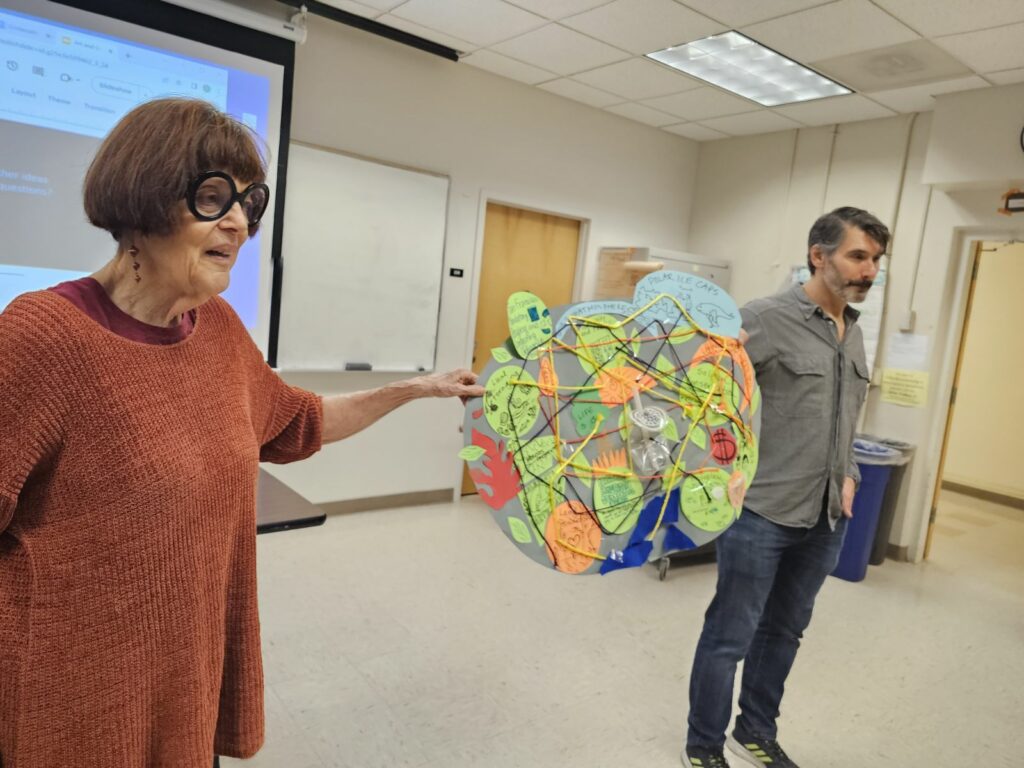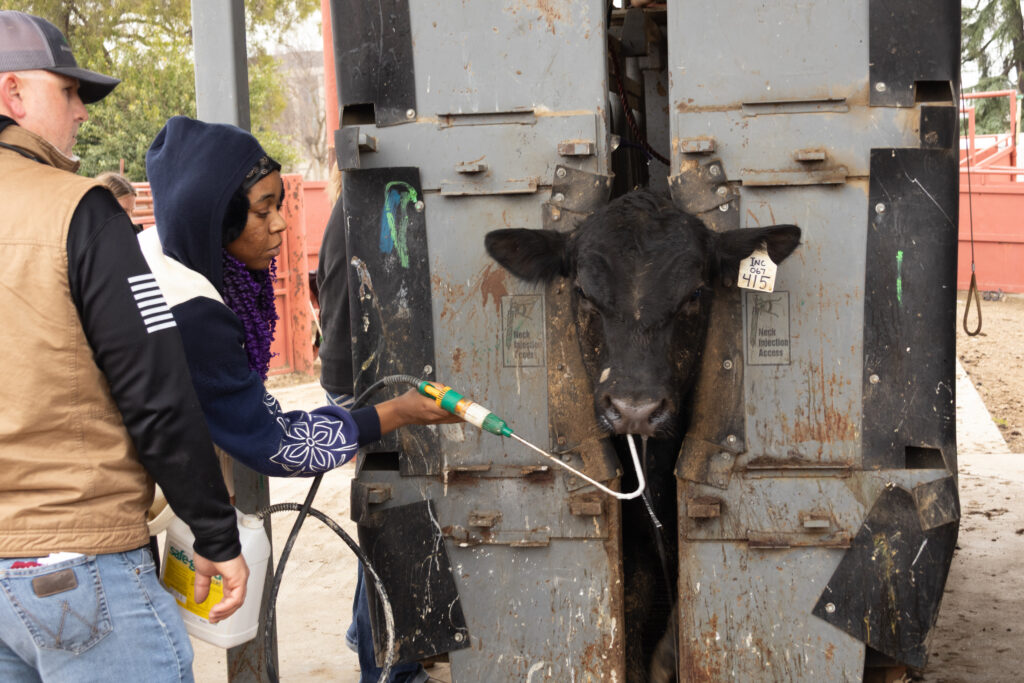
Fresno State animal science major Toi Johnson givies a bull an oral dewormer on Feb. 20, 2025, to help prevent fungal infections like ringworm from infecting and spreading to the rest of the herd. Adjunct faculty Ryan Person oversees her while other students practice giving shots to the animal.
Credit: Jesus Herrera/EdSource
In the heart of California’s bountiful Sacramento Valley lies Yuba City, a small town of about 68,000 people that is rich in agriculture and community.
This is where Taryn Chima, a fourth-year animal science major at California State University, Chico, grew up.
Growing alongside her were orchards of peaches, walnuts and almonds. Born into a third-generation farm family, Chima knew she wanted to pursue a career in agriculture from a young age. In 2021, Chima began her animal science education at Chico State.
Of the 23 campuses of California State University, just four have a college of agriculture: Cal Poly San Luis Obispo, Chico State, Fresno State and Cal Poly Pomona. This also means they have working farms that provide food for their campuses and research opportunities for ranchers and farmers in areas like regenerative agriculture, which aims to keep growing systems healthy and effective.
Students working the land
Most importantly for the students attending these schools, working on their campus farms enriches their classroom learning with hands-on experience.
Max Eatchel, a senior majoring in plant sciences at Cal Poly San Luis Obispo, had few familial ties to farming, and instead found his passion for gardening while looking for a new hobby during the Covid-19 lockdown.
“I got super into all this regenerative agriculture, sustainable agriculture, permaculture stuff, and I just went deep down that rabbit hole,” said Eatchel, who has worked on the school’s organic farm for over a year. “When it came time to apply to college, I thought, ‘Why not try plant science?’”
Until he worked on the farm, Eatchel didn’t realize how much he still had to learn in the practical application of his education. But with his graduation in June, he now feels “super prepared” for the professional world because of his hands-on experience.
“I’ve been talking to this orchard back in Utah, and they were looking for someone who could repair tractors. I really hadn’t had any experience with that,” Etchel said. “So I just asked my boss, and he’s like, ‘Yeah, we’ll get you a shift right now.’ So it’s very fluid, and it helps you build the skills you want to build.”
Similarly to Eatchel, an agricultural education wasn’t in Anthony Zaragoza’s sights at all. Zaragoza got his associate degree in biology and was planning on eventually attending medical school. That was, until a revelatory six-month experience with the Western Colorado Conservation Corps gave him a new vision.
But even when he got to Cal Poly Pomona as an agribusiness and food industry management major, he wasn’t certain how he could turn his education into a career path. Getting his first job with the student farm eased his mind.
“Out here in the city, we aren’t surrounded too much by a lot of agriculture,” Zaragoza said. “So it could be a little disheartening when we’re not having a chance to get out on an operation and see that what we’re learning is actually a feasible future for us.”
Zaragoza started as a maintenance technician at the equine center and is now the harvest assistant lead, a new position in which he works with farm operations director Jeremy Mora on the business and marketing side.
He has noticed peers in his major with the same confusion he had about how their studies translate to the working world. That is why he strongly recommends pursuing a job with the campus farms.
“They have that passion, but they really need that connection,” Zaragoza said.
For Chima, that connection and passion are enhanced at Chico State’s University Farm. “If I was not a part of a working farm, I would not be where I am today,” said Chima, who works as the lead student herdsman at the Chico State sheep unit, overseeing daily operations and supporting student research projects. “I’ve developed confidence, and I get to see a lot of different perspectives within the industry.”
-

Five Fresno State agriculture students walk bulls to their pen in the beef unit of the Fresno State farm after administering medications to the animals on Feb. 20, 2025.Credit: Jesus Herrera/EdSource
-

Fresno State agriculture education major Ava Flores loads a syringe for herself and other students to give to a beef unit bull on Feb. 20, 2025.Credit: Jesus Herrera/EdSource
-

Students handle piglets at Fresno State’s swine unit. Credit: Jesus Herrera/EdSource
-

A Chico State student holds a baby goat. Credit: Taryn Chima / Chico State
-

Students at Cal Poly San Luis Obispo till some crops at the university farm. Credit: Max Eatchel / Cal Poly, San Luis Obispo
Growing up in Salinas, Karla Ahumada was always surrounded by agriculture and knew she wanted to pursue it as a career. The fourth-year plant science and agribusiness major at Chico State has been grateful for her hands-on experiences at the university’s farm.
In a class last semester, Ahumada and her classmates were each assigned a crop to grow at the farm and were graded on how well they took care of their plots.
Since freshman year, Ahumada has also been offered paid research positions at the university farm. “It is something very unique about our farm, that we can cater to students pursuing both industry and academic focuses,” Ahumada said.
At Fresno State, agriculture education sophomore Emma Piedra works in the dairy unit doing milking and maintenance while also learning veterinary skills. The milk is used to produce cheese and ice cream sold by the school.
She has no plans to go into the dairy industry after graduation. Rather, Piedra wants to use her time at the farm to help improve her knowledge about how it works and give her future students connections to work there, just as her teachers did for her.
“Ever since getting into dairy, I’ve wanted to help students raise dairy heifers someday when I’m a teacher. So this has given me a lot of hands-on experiences of what to do and how to help them,” Piedra said.
Another Fresno State student is putting this thinking into practice at the neighboring swine unit. Hannah Williamson is a student manager and graduate teaching assistant while finishing her final semester of her agricultural science masters in animal reproduction.
Williamson grew up around the swine unit alongside her father, a professor at Fresno State. Though she worked in a few different farm units during her undergraduate years, it was her experience as a teaching assistant for the swine lab class that helped her realize she wanted to follow in her father’s footsteps and teach at the college level.
As for students considering taking some agricultural courses, she said, “I will say that the more you get involved, the better it is for you, because it opens a lot more doors. You have a lot more opportunities.”
Operating, financing student farms
Though each of these farming operations is different, they all give students experience in numerous areas of agricultural production, from cultivation and conception to marketing and accounting.
The schools have lab classes where professors can make use of the facilities for the general student population. Research opportunities and paid student positions help students gain advanced knowledge and hands-on skills.
“We hear often from employers that they really like our students because they can actually do stuff,” said Jim Prince, Cal Poly San Luis Obispo’s associate dean of the College of Agriculture.
The San Luis Obispo campus has a range of farms and production facilities, including a vineyard, beef production and ornamental operations, among others. This may sound expensive to operate, and though Prince says it is a “complex mix” of funding, most of the farms are self-supported through their food production businesses.
Among the products they sell are cheese, ice cream, jam, meat, organic produce, plants and wine. Most of these are available through their online shop as well as the campus markets, and some are available through local retailers. The organic produce is sold directly at local farmers’ markets and during the farm’s U-pick hours.
The Chico State University Farm has a similar mix of financial support. It consists of 14 units and employs 18 full-time staff and 40 students.
All four universities were each awarded $18.75 million in a grant from California’s 2022-23 budget. For Chico, $11.5 million of that is funding the Agricultural Teaching Center and Farm Store, which is expected to be operating by this fall, according to College of Agriculture interim associate dean Kevin Patton. Amid statewide CSU budget cuts, Patton believes this money will not be touched.
Chris Van Norden graduated from Cal Poly Pomona with a plant sciences degree and continued working on the campus farm until he became the agronomy farm coordinator, overseeing 125 acres. His brother, Bryan, also an alum, runs the orchard, organic farm and sales.
California agricultural production variety is extremely diverse, and Van Norden said their 700 acres of farms are well-suited to familiarize the student assistants with a wide range of career possibilities.
“We’ve got (year-round) overlapping egg production, vegetables, permanent trees (and) subtropical, growing everything possible in California,” Van Norden said. “And showing the students that, ‘Hey, you could do any of this with agriculture,’ it’s a … giant, wide spectrum of agricultural potential.”
Vincent Roos, the farm operations manager at Fresno State, emphasized the school’s unique position in the Central Valley, which allows for the growth of nearly 400 different crops.
He noted the importance of hands-on experience in preparing students for diverse agricultural careers.
“In other words, they can take anything, any kind of circumstances that you’re in, and make it work,” Roos said.
Jesus Herrera is a third-year journalism student at Fresno State; Layla Bakhshandeh is a senior at Cal Poly San Luis Obispo majoring in journalism and graphic communication; and John Washington is a senior journalism student at Cal Poly San Luis Obispo. All are members of EdSource’s California Student Journalism Corps.












)
)







